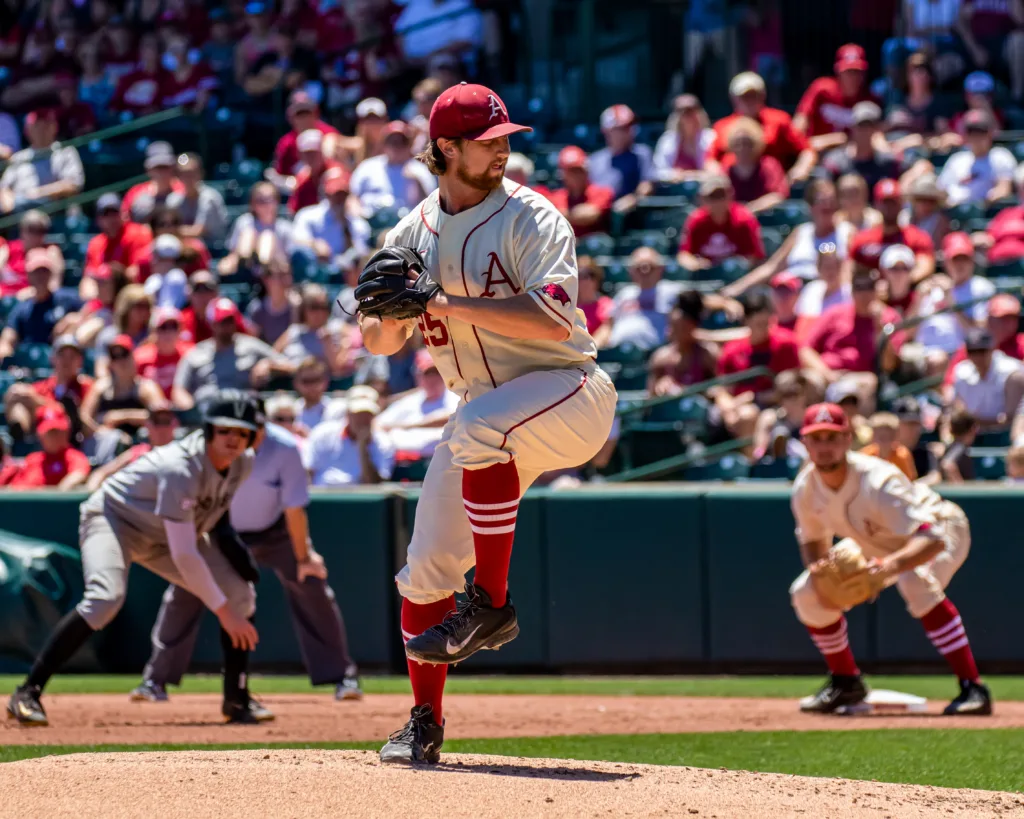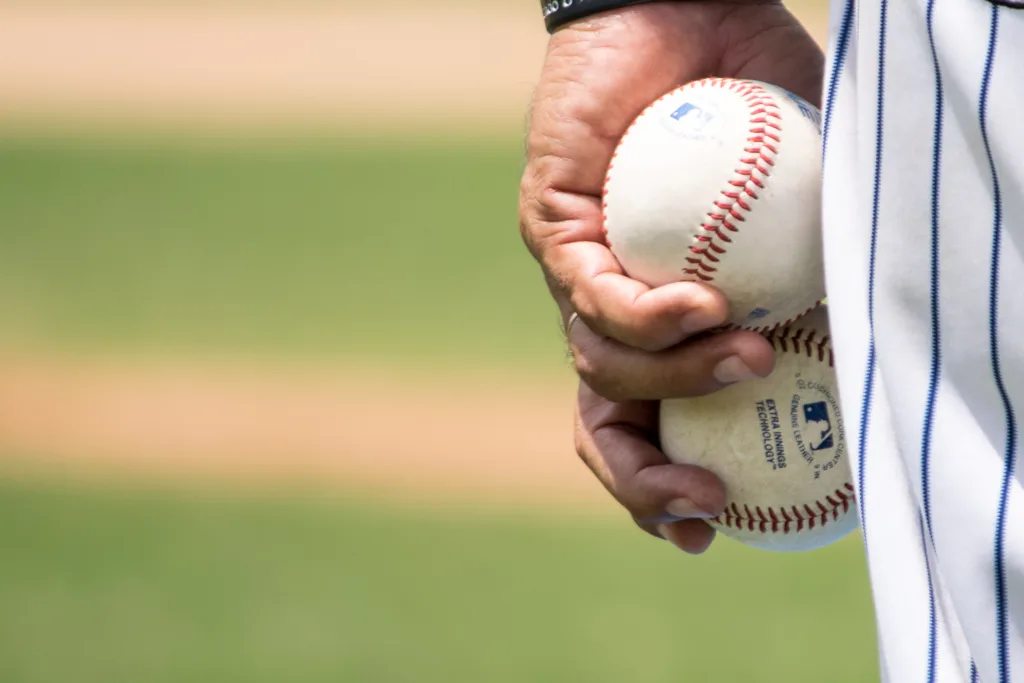A running fastball, also known as a two-seam fastball, is a pitch that has become increasingly popular among pitchers in recent years. This pitch is known for its lateral movement, making it incredibly effective against batters with the same handedness. Unlike a four-seam fastball, which typically travels in a straight line, a running fastball moves just out of the strike zone before crossing the plate.
The key to throwing a successful running fastball is to grip the ball correctly. This pitch is typically thrown with a two-seam grip, which involves placing the index and middle fingers along the seams of the baseball. The pitcher then throws the ball with a slight sidearm motion, which causes the ball to spin and move laterally as it approaches the plate.
One of the biggest advantages of the running fastball is its ability to deceive batters. Because the ball appears to be headed towards the strike zone, batters are often tempted to swing at it, only to have the ball veer away at the last moment. This can lead to weak contact or a swing and a miss, making the running fastball an incredibly effective pitch.
Another advantage of the running fastball is its effectiveness against left-handed batters. When thrown correctly, the ball will move away from a left-handed batter, making it difficult for them to make solid contact. This can be especially effective when combined with a well-placed changeup or breaking ball, as it keeps the batter off balance and guessing at what pitch is coming next.
Of course, like any other pitch, the running fastball does have its limitations. Because it moves laterally, it can be difficult for pitchers to control, especially when throwing to the inside part of the plate. Additionally, some pitchers may struggle to consistently generate enough movement on the pitch to make it effective.
Despite these limitations, the running fastball remains a valuable weapon in the arsenal of many pitchers. Its ability to deceive batters and generate weak contact make it a valuable tool for getting outs and keeping opposing teams off the scoreboard. As the game continues to evolve, it will be interesting to see how pitchers continue to incorporate this pitch into their repertoire.
Is A Running Fastball Good?
A Running Fastball can be a highly effective pitch when executed correctly. It is a type of fastball that has more lateral movement than a traditional fastball, making it particularly effective aginst batters who bat from the same side as the pitcher. This pitch is often used to induce a ground ball or a weakly hit ball, making it a valuable tool for pitchers who want to induce a quick out. However, like any pitch, the success of the Running Fastball depends on the skill and execution of the pitcher. It is important for pitchers to master the technique of the pitch and use it strategically to keep batters off balance and guessing at the plate.

What’s The Difference Between A Running Fastball And A Two-seam Fastball?
A running fastball and a two-seam fastball are both types of pitches in baseball, but they have some distinct differences. A running fastball, also known as a tailing fastball, moves horizontally away from the left-handed batter. It is usually thrown to the outside of the plate, just out of the strike zone, to induce the batter to swing and miss or hit a weak ground ball.
On the other hand, a two-seam fastball, also known as a sinking fastball, moves vertically downwards towards the ground. It is thrown with a grip that puts pressure on the ball to cause it to drop as it approaches the batter. Because of this movement, the two-seam fastball is often used to induce ground balls and double plays.
The main difference between a running fastball and a two-seam fastball is the direction of the movement. A running fastball moves horizontally away from the batter, while a two-seam fastball moves vertically towards the ground.
What Are The Four Main Types Of Fastball?
There are four main types of fastball in baseball. These include the four-seam fastball, two-seam fastball, cutter, and splitter.
1. Four-seam fastball: This is the most common type of fastball. It involves gripping the ball with the index and middle fingers across the seams. When thrown, the ball travels straight with little to no movement, making it easier for the pitcher to control.
2. Two-seam fastball: This fastball is gripped with two fingers on the seams, rather than across them. When thrown, the ball has a slight movement to the pitcher’s arm side, making it more difficult for batters to hit.
3. Cutter: Also known as a cut fastball, this pitch involves gripping the ball off-center with the index and middle fingers. It has a slight cutting action that moves in on the hands of a right-handed batter or away from a left-handed batter.
4. Splitter: This pitch is thrown by gripping the ball with the index and middle fingers spread apart, creating a “split” in the grip. When thrown, the ball drops sharply, making it difficult for batters to hit.
These are the four main types of fastball in baseball, each with thir own unique grip and movement.
Is A 110 Mph Fastball Possible?
As of now, a 110 mph fastball is considered almost impossible. While there have been pitchers who have thrown in the triple digits, the fastest pitch ever recorded was 105 mph by Aroldis Chapman in 2010.
There are several factors that come into play when it comes to throwing a baseball at such a high speed. Firstly, the human body has physical limitations in terms of how fast it can move. The fastest recorded sprint speed by a human is around 28 mph, and that’s for a short distance. To throw a baseball at 110 mph, the pitcher would have to move their arm at an incredibly fast speed, which is difficult to achieve without causing injury.
Secondly, even if a pitcher could move their arm fast enough, there are limitations to how much force the human body can generate. The force required to throw a baseball at 110 mph would be immense, and it’s unlikely that any human could generate that much force without causing serious injury.
Lastly, the aerodynamics of a baseball also play a crucial role. As a ball travels through the air, air resistance slows it down. The faster a ball is thrown, the greater the air resistance, and at some point, the air resistance becoes too great for the ball to travel any faster.
While it’s possible that someone could throw a baseball at 110 mph in the future, it’s considered highly unlikely due to the physical limitations of the human body and the aerodynamics of a baseball.

Conclusion
The running fastball is a highly effective pitch in baseball that can be used to deceive batters, especially those of the same handedness. It has a lateral movement that makes it difficult to hit and can be thrown to the outside to run away from left-handed batters. Also known as a two-seamer, it moves out of the strike zone beore crossing the plate, making it a tricky pitch to master. While there are several types of fastballs, breaking balls, and changeups, the running fastball remains a popular and effective pitch in the game of baseball. Its unique movement and ability to confuse batters make it a valuable tool in any pitcher’s arsenal.
